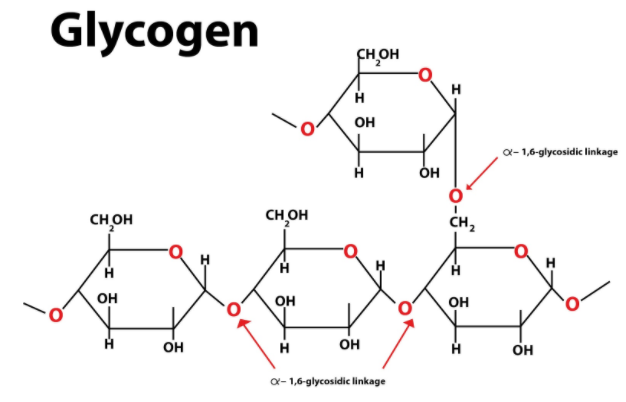
Which one of the following is a polysaccharide?
(a)Glycogen
(b)Sucrose
(c)Lactose
(c)Maltose
Answer
507.9k+ views
1 likes
Hint: The main source of energy present in animals including humans, fungi, and bacteria. It is a polymer of glucose chains having 8-10 units of glucose and is commonly called ‘animal starch’.
Complete answer:
Glycogen is a polysaccharide of glucose which is the main storage compound in the body especially in the liver and the muscles. It gives energy to the body during low glucose levels.
Additional Information:
-Polysaccharides are the most common type of carbohydrates present in our food.
-The monosaccharides together, when attached through glycosides bond, will result in the formation of the polysaccharides.
-The most common type of polysaccharides is glycogen and starch. They are also known as the storage polysaccharides.
-The other type of polysaccharide is known as the structural polysaccharides which are chitin, and cellulose. They are present in the cell wall of particular organisms.
-Glycogen is stored for longer periods in the adipose tissue (fat cells) known as triglycerides.
-Glycogen is secreted when the number of insulin increases and when the glucagon is present then it will break down into the molecules of glucose.
-From the liver, the stored glycogen is transported to the brain and the spinal cord.
-Glycogen is also stored in various other organs including blood.
-The glycogen which is stored in the form of glucose is about 14% in the liver, 80% in skeletal muscle, and 6% in the blood.

So, the correct answer is, “Glycogen.”
Note: Claude Bernard was the first scientist to describe glycogen in 1857, in his experiment glycogen as the ‘sugar forming substance' in the liver. In 1858, Kekule established the empirical formula of glycogen and was later found that they are also present in the muscular tissue by A. Sanson. Lactose and maltose are disaccharides that are made up of glucose.
Complete answer:
Glycogen is a polysaccharide of glucose which is the main storage compound in the body especially in the liver and the muscles. It gives energy to the body during low glucose levels.
Additional Information:
-Polysaccharides are the most common type of carbohydrates present in our food.
-The monosaccharides together, when attached through glycosides bond, will result in the formation of the polysaccharides.
-The most common type of polysaccharides is glycogen and starch. They are also known as the storage polysaccharides.
-The other type of polysaccharide is known as the structural polysaccharides which are chitin, and cellulose. They are present in the cell wall of particular organisms.
-Glycogen is stored for longer periods in the adipose tissue (fat cells) known as triglycerides.
-Glycogen is secreted when the number of insulin increases and when the glucagon is present then it will break down into the molecules of glucose.
-From the liver, the stored glycogen is transported to the brain and the spinal cord.
-Glycogen is also stored in various other organs including blood.
-The glycogen which is stored in the form of glucose is about 14% in the liver, 80% in skeletal muscle, and 6% in the blood.

So, the correct answer is, “Glycogen.”
Note: Claude Bernard was the first scientist to describe glycogen in 1857, in his experiment glycogen as the ‘sugar forming substance' in the liver. In 1858, Kekule established the empirical formula of glycogen and was later found that they are also present in the muscular tissue by A. Sanson. Lactose and maltose are disaccharides that are made up of glucose.
Latest Vedantu courses for you
Grade 11 Science PCM | CBSE | SCHOOL | English
CBSE (2025-26)
School Full course for CBSE students
₹41,848 per year
Recently Updated Pages
Master Class 11 Business Studies: Engaging Questions & Answers for Success

Master Class 11 Accountancy: Engaging Questions & Answers for Success

Master Class 11 Computer Science: Engaging Questions & Answers for Success

Master Class 11 English: Engaging Questions & Answers for Success

Master Class 11 Social Science: Engaging Questions & Answers for Success

Master Class 11 Economics: Engaging Questions & Answers for Success

Trending doubts
Which one is a true fish A Jellyfish B Starfish C Dogfish class 11 biology CBSE

State and prove Bernoullis theorem class 11 physics CBSE

1 ton equals to A 100 kg B 1000 kg C 10 kg D 10000 class 11 physics CBSE

In which part of the body the blood is purified oxygenation class 11 biology CBSE

One Metric ton is equal to kg A 10000 B 1000 C 100 class 11 physics CBSE

Difference Between Prokaryotic Cells and Eukaryotic Cells




